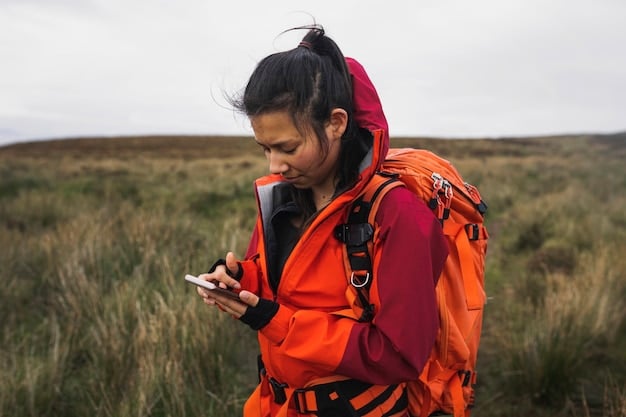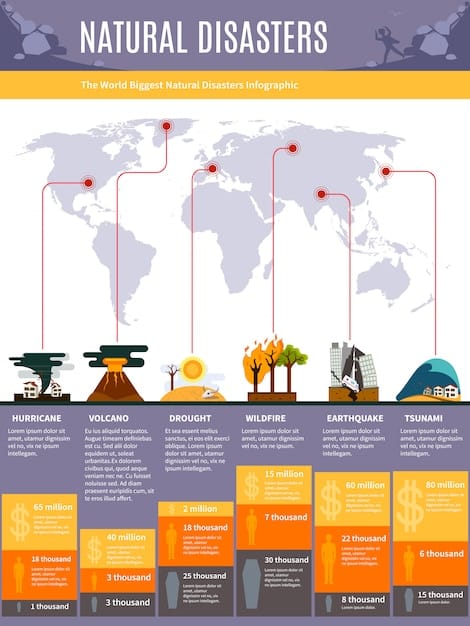Natural Disaster Preparedness: Your Travel Safety Guide

Natural Disaster Preparedness: Staying Safe During Travel in High-Risk Areas involves proactive planning, including researching potential hazards, securing travel insurance, creating emergency plans, and staying informed through local news and weather alerts.
Traveling to exotic locales can be exciting, but it’s crucial to prioritize your safety, especially when visiting regions prone to natural disasters. Natural Disaster Preparedness: Staying Safe During Travel in High-Risk Areas requires thoughtful planning and awareness, ensuring you’re well-equipped to face any unforeseen circumstances.
Understanding the Risks: Identifying High-Risk Destinations
Before embarking on your adventure, it’s vital to understand the specific risks associated with your chosen destination. Researching the area’s history of natural disasters allows you to anticipate potential hazards and plan accordingly.
Common Natural Disasters in Travel Destinations
Different regions are susceptible to various natural disasters. Some areas face hurricanes, while others are prone to earthquakes, tsunamis, volcanic eruptions, or wildfires. Understanding these risks is the first step in preparing for your trip.
- Hurricanes/Typhoons: Coastal regions in the Caribbean, Southeast Asia, and the Pacific are frequently affected by hurricanes and typhoons.
- Earthquakes: Areas along major fault lines, such as California, Japan, and parts of South America, are prone to earthquakes.
- Flooding: Low-lying areas and regions near rivers are at higher risk of flooding, especially during monsoon seasons.
- Volcanic Eruptions: Regions near active volcanoes, such as Indonesia, Iceland, and Hawaii, may experience volcanic eruptions.

By identifying these risks, you can tailor your preparation efforts to address the specific hazards you might encounter during your travels.
Planning Ahead: Essential Preparations Before You Go
Effective natural disaster preparedness starts long before you pack your bags. Thorough planning can significantly increase your safety and well-being during your travels.
Travel Insurance and Medical Coverage
Invest in comprehensive travel insurance that covers medical emergencies, trip cancellations, and evacuation expenses. Make sure you understand the policy’s coverage limits and exclusions, particularly those related to natural disasters.
Emergency Contact Information
Create a list of emergency contact information, including local emergency services, your embassy or consulate, family members, and your insurance provider. Keep a physical copy of this list in your wallet or backpack, as well as storing it digitally on your phone.
- Local Emergency Numbers: Research and note down the local emergency numbers for police, fire, and ambulance services in your destination.
- Embassy/Consulate Contact: Locate the contact details for your country’s embassy or consulate in your destination. They can provide assistance in emergencies.
- Family and Friends: Ensure family and friends have your travel itinerary and contact information so they can reach you or provide assistance if needed.
By preparing these essential documents and contact details, you are setting a strong foundation for a safer journey.
Packing Smart: Building Your Disaster Preparedness Kit
A well-stocked disaster preparedness kit can make a significant difference in your ability to cope with emergencies during your travels. Customize your kit to suit your needs and the specific risks of your destination.
Essentials for Your Travel Emergency Kit
Your emergency kit should include essential items to help you survive and stay safe during a natural disaster. Adapt the contents based on the region’s climate and potential hazards.
- Water and Non-Perishable Food: Pack enough water and non-perishable food items, such as energy bars and dried fruits, to last at least three days.
- First-Aid Kit: Include a comprehensive first-aid kit with bandages, antiseptic wipes, pain relievers, and any personal medications.
- Flashlight and Batteries: Carry a reliable flashlight and extra batteries to provide light during power outages.
- Whistle: A whistle is an effective signaling device to attract attention in an emergency.

Clothing and Protection
Pack appropriate clothing and protective gear to prepare for various weather conditions and potential hazards.
Consider packing a lightweight, waterproof jacket, sturdy footwear, and a hat to protect yourself from the elements.
Staying Informed: Monitoring Weather and Local News
Staying informed about weather forecasts and local news is crucial for making informed decisions during your travels. Regularly monitor these sources to stay updated on potential threats and take preventive measures.
Utilizing Weather Apps and Alerts
Download weather apps that provide real-time updates and alerts for your location. Enable notifications to receive warnings about severe weather conditions, such as hurricanes, floods, or wildfires.
Following Local News and Social Media
Stay connected to local news outlets and social media channels to receive timely information about emergencies and evacuation orders. These sources can provide valuable insights into local conditions and potential risks.
By staying informed and proactive, you can adapt your plans and take appropriate measures to protect yourself and your travel companions.
During a Disaster: Reacting Safely and Effectively
Knowing how to react during a natural disaster can significantly improve your chances of survival. Familiarize yourself with safety protocols and emergency procedures to respond effectively in a crisis.
Following Evacuation Orders and Safety Protocols
If an evacuation order is issued, follow it immediately and comply with instructions from local authorities. Move to designated safe zones or shelters, and assist others if possible.
Seeking Shelter and Staying Safe
When sheltering in place, seek refuge in a sturdy building and stay away from windows and doors. Follow safety guidelines for the specific type of disaster, such as staying indoors during a hurricane or dropping, covering, and holding on during an earthquake.
- During a Hurricane: Stay indoors, away from windows, and seek shelter in an interior room or hallway on the lowest level of the building.
- During an Earthquake: Drop to the ground, cover your head and neck, and hold on to a sturdy object. Stay away from windows and doors.
- During a Flood: Move to higher ground and avoid walking or driving through floodwaters.
By knowing how to react promptly and effectively during a natural disaster, you can increase your chances of staying safe and minimizing potential harm.
After the Disaster: Assessing the Situation and Getting Help
After a natural disaster, assessing the situation and seeking assistance are crucial steps for recovery. Follow safety guidelines, check for injuries, and contact emergency services if necessary.
Assessing Your Safety and Helping Others
Check yourself and others for injuries, and provide first aid as needed. Be cautious of potential hazards, such as downed power lines, damaged buildings, and contaminated water sources.
Contacting Emergency Services and Your Embassy
If you require medical assistance or evacuation, contact local emergency services and your embassy or consulate. Provide them with your location and a description of your situation, and follow their instructions.
By being proactive and responsible after a natural disaster, you can contribute to the recovery effort and ensure your well-being during challenging circumstances.
| Key Point | Brief Description |
|---|---|
| ⚠️ Research Hazards | Identify potential natural disasters prone to your destination. |
| ⛑️ Insurance & Contacts | Secure travel insurance and have emergency contacts handy. |
| 🎒 Emergency Kit | Pack essentials like water, food, first-aid, and a flashlight. |
| 📱 Stay Informed | Monitor weather apps and local news for updates. |
FAQ
▼
The first step is to research the potential natural hazards specific to your travel destination to understand the risks.
▼
Travel insurance can cover medical emergencies, trip cancellations, and evacuation expenses related to natural disasters, providing financial protection.
▼
Your kit should include water, non-perishable food, a first-aid kit, a flashlight, batteries, and a whistle for signaling in emergencies.
▼
Monitor weather apps, local news, and social media channels for real-time updates and warnings about severe weather conditions.
▼
Follow the evacuation order immediately and comply with instructions from local authorities, moving to designated safe zones or shelters.
Conclusion
Being prepared for natural disasters while traveling is essential for your safety and well-being. By understanding the risks, planning ahead, packing a disaster preparedness kit, staying informed, and knowing how to react during a crisis, you can minimize potential harm and enjoy your travels with greater peace of mind.





